The environment of communication technology is continually evolving, presenting businesses with a range of opportunities to enhance productivity, streamline operations, and improve overall customer experiences. VoIP is one such innovation that has reshaped the way call centers operate.
In this comprehensive exploration of VoIP for call centers, we will explore why VoIP is not only a convenient and cost-effective solution but also a necessity in the modern business environment.
So if you are a call center manager you will gain valuable insights into the extensive benefits, deployment strategies, customized features, as well as future trends of VoIP technology in call center operations.
What is VoIP for call centers?
A VoIP call center utilizes Voice over Internet Protocol technology to handle calls over the Internet instead of making calls through traditional phone lines. This modern approach surpasses the limitations of traditional telephony and offers advanced features that enhance customer service.
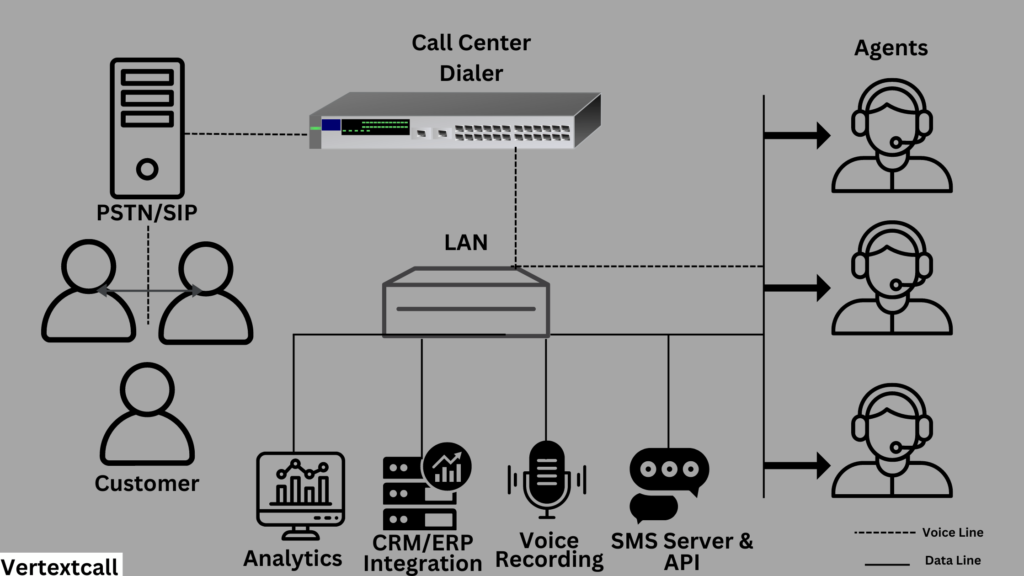
With VoIP, your call centers can operate remotely, ensuring uninterrupted service regardless of location. This technology provides your call center agents with tools for efficient call management (both inbound and outbound), data analysis, and customer interaction, increasing productivity and satisfaction.
Must Read: What is VoIP and How Does it Work
Why should a call center use a VoIP solution?
Adopting a VoIP solution offers various advantages for call centers, making it an attractive choice for modernizing communications. Here are several compelling reasons why a call center should consider using a VoIP solution:
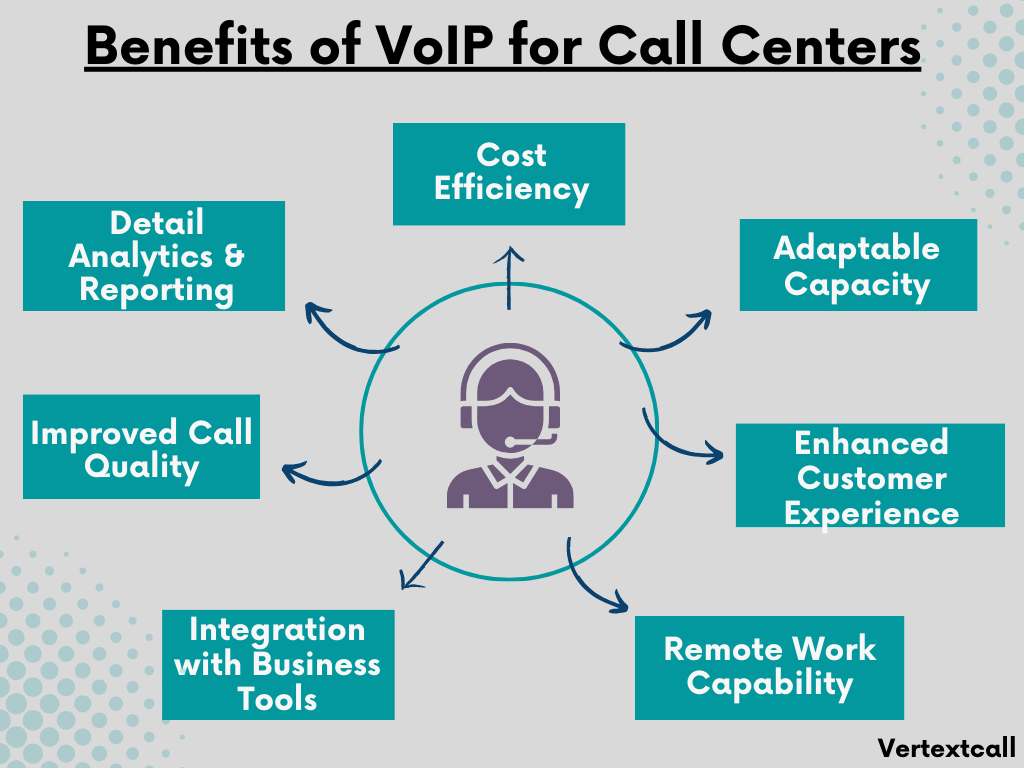
- Cost Efficiency: VoIP can drastically cut operational costs in call centers by removing the requirement for traditional phone systems and long-distance fees. This allows for a more economical deployment of resources towards enhancing customer service and agent training.
- Adaptable Capacity: The flexibility of VoIP solutions allows call centers to easily adjust their capacity to meet demand without the challenges of traditional telephony systems. This adaptability is crucial if you want to manage fluctuating call volumes and business expansion within your call center.
- Enhanced Customer Experience: Features like call routing, interactive voice response (IVR), and call analytics allow for a personalized customer experience. VoIP technology can quickly direct your customers to the most appropriate agent from your team or provide them with self-service options, reducing wait times and improving satisfaction.
- Remote Work Capability: VoIP technology embraces the modern remote work trend, enabling your agents to work from any location with internet access. This not only expands the talent pool but also ensures continuity of service during unpredictable occurrences, including natural disasters and health emergencies.
- Integration with Business Tools: VoIP systems offer the capability to integrate effortlessly with your current Customer Relationship Management (CRM) platforms, helpdesk applications, and other essential business tools. This integration provides your agents with comprehensive customer information at their reach, leading to more personalized and efficient service.
- Improved Call Quality: With advancements in VoIP technology, issues of call latency, jitter, and packet loss have been minimized, leading to clearer and more reliable voice communications. This enhances both the customer’s and the agent’s interaction experience.
- Comprehensive Analytics and Reporting: VoIP systems offer detailed analytics and reporting capabilities that allow call centers to monitor and analyze call quality, agent performance, and customer satisfaction in real time. This data is valuable for continuous improvement and strategic decision-making within your call center.
How to set up a VoIP call center
Setting up a VoIP call center involves strategic and technical steps designed to optimize operations and ensure efficient communication. Here is a detailed outline of how to establish a VoIP call center effectively:
1/ Assess Needs and Requirements: Start by evaluating your call center’s specific needs including call volume, number of agents, and the desired features in a VoIP system (e.g., IVR, call recording, analytics). This assessment will guide your selection process for the right VoIP provider and solution.
2/ Choose a Reliable VoIP Provider: Select a VoIP service provider that offers a balance of features, reliability, scalability, and cost-effectiveness. Look for providers with experience in serving call centers and who offer reliable customer support.
Note: We have listed the top VoIP call center software providers later in the article.
3/ Design Your Call Center Structure: Determine the structure of your call center including the distribution of agents (remote or on-site), departmental divisions, and how calls will be routed to maximize the full potential of VoIP functionality.
4/ Invest in Appropriate Hardware and Software: While VoIP reduces the need for traditional telephony hardware, ensuring your team has VoIP-compatible headsets, adequate computers, and reliable internet connectivity is critical. Additionally, consider any software integrations needed for operations, such as CRM or analytics platforms.
5/ Setup VoIP System and Configure Features: Work with your VoIP provider to set up your account, configure call routing paths, set up IVR menus, and activate any other relevant features. Personalize these settings to match your call flow and customer interaction goals.
6/ Integrate with Business Tools: Integrate your VoIP system with essential business tools like CRM software, helpdesk applications, and any other tools your agents use. This integration centralizes data, streamlining processes and enhancing customer interactions.
7/ Train Your Team: Educate your agents and support staff on how to use the new VoIP system, focusing on features they will use daily. Effective training improves adoption rates and ensures your team can benefit from the VoIP system’s capabilities to enhance customer service.
8/ Test the System Thoroughly: Before moving to live settings, thorough testing is crucial to confirm the system’s operational integrity. Check call quality, feature functionality, and integrations to guarantee a smooth transition for both your team and your customers.
Once testing is complete, go live with your new VoIP call center. Continuously monitor the system performance, and agent productivity, and carefully gather and analyze customer feedback.
Additionally, use analytics and reporting features to assess the effectiveness of your VoIP call center. Regularly review these insights to identify optimization opportunities, and adjust strategies and configurations as necessary to improve operations and customer satisfaction.
VoIP Features Tailored for Call Centers
VoIP technology provides a set of functionalities suited to improve the performance of call center operations. These features not only improve the customer’s experience but also empower agents and simplify management tasks. Here is a comprehensive list of VoIP features that are particularly beneficial for call centers:
1/ Interactive Voice Response (IVR): Enables callers by providing self-service options, enabling them to navigate through simple tasks independently. This not only reduces the burden on agents for routine tasks but also improves customer satisfaction by delivering a smooth experience
2/ Automatic Call Distribution (ACD): Systematically distributes incoming calls to available agents based on predetermined criteria such as caller need, language, or agent skill level.
3/ Call Queuing: Manages incoming call traffic by placing calls in a queue when agents are busy, providing callers with estimated wait times and the option to receive a callback.
4/ Call Recording: Essential for quality assurance and training purposes, call recording allows call centers to monitor and review calls for service improvement and compliance with legal and industry standards.
5/ Call Monitoring and Barging: Allows supervisors to monitor live calls discreetly, offering real-time feedback and intervention if needed, without the agent or customer being aware.
6/ Call Analytics and Reporting: Provides valuable insights through the analysis of call data, including call volume, time, duration, and agent performance. This feature enables call centers to make informed decisions to optimize operations and customer interactions.
7/ Caller ID and Call Blocking: Identifies incoming callers and allows blocking of unwanted numbers to protect agents from harassment or spam.
8/ Real-Time Status and Presence Information: Displays the availability status of agents, making it easier to manage call assignments and team collaborations.
9/ Customizable Call Routing: Offers the flexibility to create complex call flow structures, ensuring that calls are routed according to business hours, agent skills, or other criteria.
These features, when optimally utilized, can transform your call center’s operations, enhancing both customer satisfaction and business performance.
Difference between VoIP and call center
VoIP and a call center are different concepts, each serving different purposes, but they can be closely related when it comes to modern telecommunications and customer service operations. Here’s an overview of the differences:
Aspects of defferentiation | VoIP | Traditional Call Center |
Infrastructure Requirements | Primarily software-based, requiring minimal physical infrastructure. | Requires extensive hardware and physical phone lines. |
Flexibility and Scalability | Highly flexible and easily scalable to meet changing business needs. | Scaling can be complex and costly due to physical infrastructure. |
Cost Efficiency | Generally more cost-effective due to reduced hardware needs and lower call costs. | Often more expensive due to maintenance, hardware, and higher call rates. |
Integration with Other Systems | Easily integrates with CRM, analytics, and other business tools. | Integration is possible but may be less seamless and more complex. |
Remote Work Compatibility | Naturally supports remote work with agents able to connect from anywhere. | Adapting to remote work can be challenging and may require significant adjustments. |
Innovative Features | Offers advanced features like IVR, call analytics, and customizable call routing. | May lack modern features and capabilities found in VoIP solutions. |
Call Quality | Dependent on internet quality, but advancements have significantly improved reliability. | Generally stable, but dependent on traditional telephony networks. |
Maintenance and Upgrades | Software-based updates are often seamless and require less physical upkeep. | May require physical maintenance and hardware upgrades, leading to potential downtime. |
Best VoIP services for medium to large call centers
The following list includes top VoIP providers, each offering unique features tailored to support efficient call center functions.
1/ RingCentral Contact Center Solution
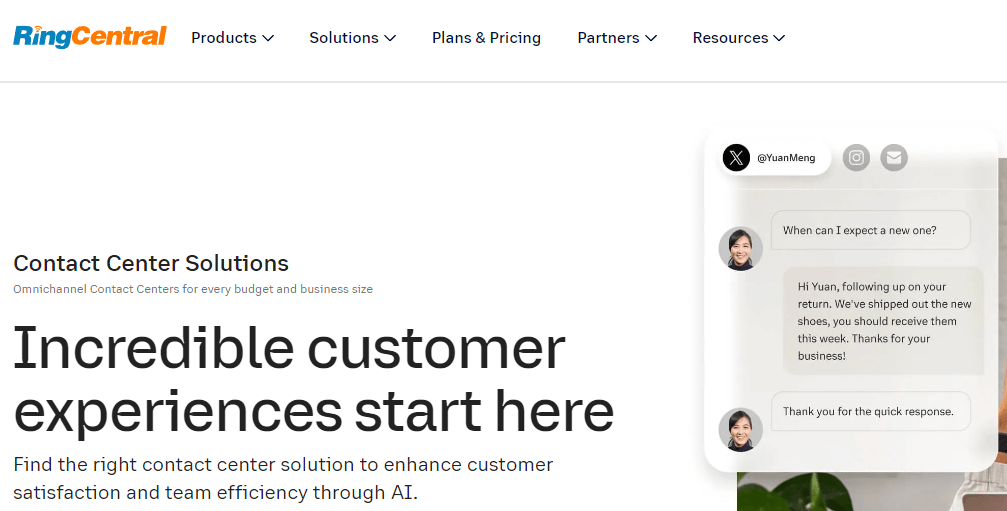
RingCentral is a leading cloud communication platform that offers a comprehensive suite of VoIP services. Known for its reliability and ease of use, it caters to businesses of all sizes, with a particular focus on enhancing call center operations.
Features:
- Omnichannel Support: Enables call center representatives to engage with clients through multiple platforms, including voice calls, messaging, email, and social networking sites.
- Advanced Call Management: Features like call routing, screening, and forwarding optimize call handling.
- Analytics and Reporting: Offers detailed insights into call data, helping managers make informed decisions.
- Integration Capabilities: Seamlessly integrates with popular CRM systems, enhancing customer interaction.
- Scalability: Effortlessly adapts to support business expansion, without the necessity for substantial modifications to infrastructure.
Pricing: RingCentral’s pricing varies based on the selected plan, starting at $65 per user per month.
2/ 8×8:
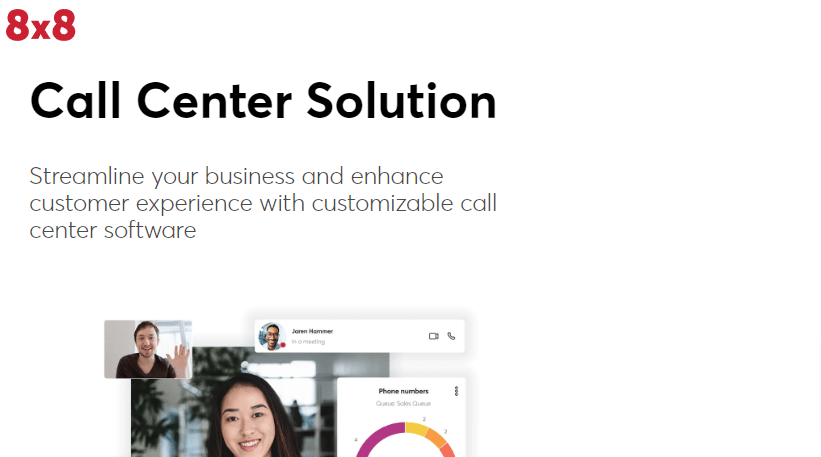
8×8 provides cloud-based VoIP solutions, offering exceptional voice, video, and mobile communications for call centers. It is known for its global consistency and end-to-end encrypted security measures.
Features:
- Cross-Platform Messaging: Supports real-time messaging across platforms, ensuring cohesive communication.
- Video Conferencing: High-quality video conferencing capabilities for internal and external communications.
- Virtual Office Analytics: Comprehensive analytics suite for call and video interaction monitoring.
- Cloud Contact Center: A unified cloud contact center that enhances customer experiences across all touchpoints.
- Mobile Apps: Offers mobile applications for iOS and Android, facilitating remote work and flexibility.
Pricing: 8×8’s pricing is tailored to different business needs and starts at $25 per user per month.
3/ Vonage:
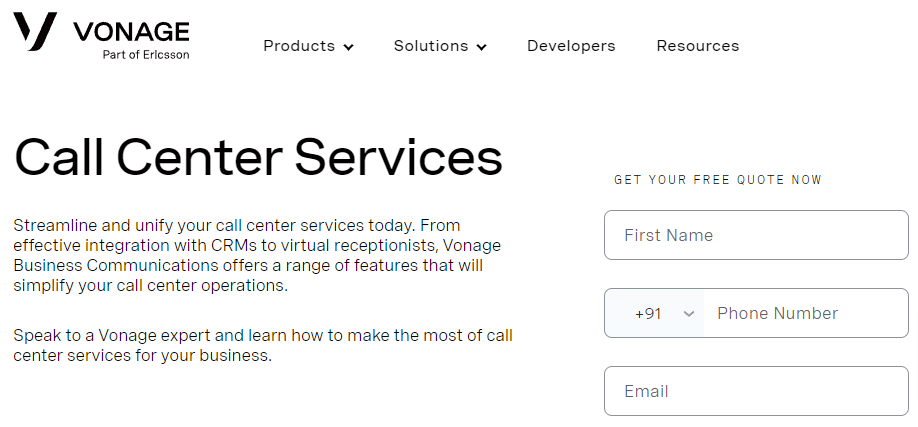
Vonage is renowned for its innovative VoIP solutions, offering versatile communication tools for businesses. It emphasizes customizability and integration to improve call center efficiency and customer engagement.
Features:
- Customizable Communications: Tailor-made communication solutions to fit specific business needs.
- CRM Integration: Direct integration with various CRM platforms to enhance customer service and insight.
- SmartWAN: Optimizes internet connectivity for superior call quality, even under heavy use.
- Workforce Optimization: Tools and analytics for improving agent performance and customer interactions.
- Unified Communications: A single platform for voice, video, messaging, and data services.
Pricing: Vonage offers pricing plans starting from $13.99 per line per month.
4/ Nextiva:
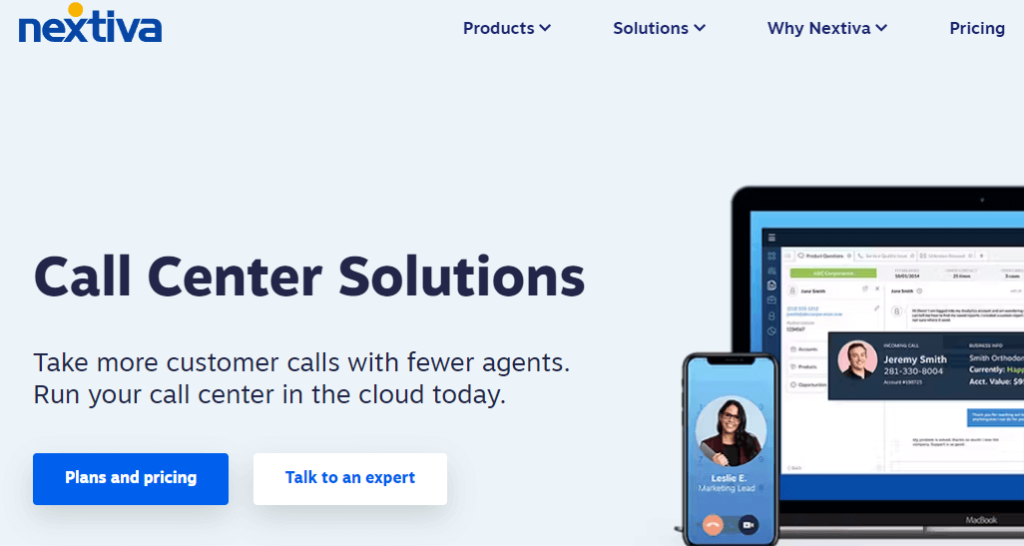
Nextiva stands out for its exceptional customer service and user-friendly VoIP solutions. It provides a unified suite of communication tools that support scalable and efficient call center operations.
Features:
- NextOS Platform: A unified communications platform that provides an integrated view of customer engagements.
- Team Collaboration: Enhances team coordination with tools for messaging, file sharing, and task management.
- Automated Surveys: Automated feedback collection to measure and improve customer satisfaction.
- Call Pop: Provides instant customer information as the call is connected, personalizing the customer experience.
- Reliability: Offers a 99.999% uptime guarantee, ensuring consistent operation.
Pricing: Nextiva’s pricing structure begins at $50 per user per month.
5/ Five9:
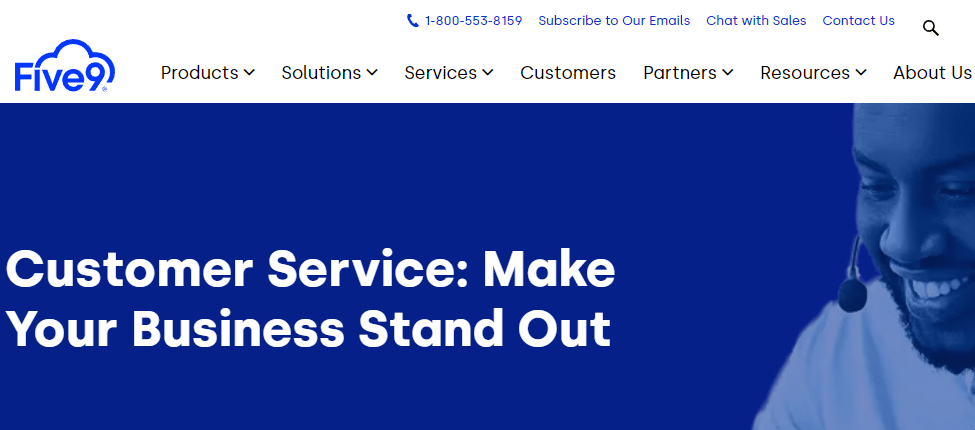
Five9 is a powerful VoIP service provider specializing in cloud contact centers that leverages AI and automation to transform customer service interactions. It is designed for large-scale operations needing reliable functionality and high flexibility.
Features:
- Intelligent Cloud Contact Center: Offers advanced AI capabilities for efficient call routing and customer interaction.
- Multichannel Support: Supports voice, video, chat, email, and social media on a single platform.
- Predictive Dialer: Increases agent productivity by connecting agents only to live respondents.
- VoiceStream: Real-time access to voice interactions for comprehensive analysis and monitoring.
- Workforce Optimization Tools: Promotes agent training and performance monitoring to meet call center goals efficiently.
Pricing: Five9’s pricing structure is customized based on specific business requirements.
What are the implications of VoIP for call centers and how can it improve customer services, analytics, and agent productivity?
Voice over Internet Protocol (VoIP) has brought about substantial changes to call centers, impacting customer service delivery, data analytics usage, and agent productivity.
Firstly, as discussed above by integrating with Customer Relationship Management (CRM) systems, VoIP enables a personalized customer service approach.
Agents can access real-time data and interaction histories during calls, leading to more efficient problem-solving and customer satisfaction.
Secondly, VoIP provides call centers with strong analytics tools to monitor performance metrics like call volume, wait times, and agent productivity.
By analyzing this data, managers can pinpoint operational inefficiencies and adjust their strategies to better align with consumer needs and expectations.
Lastly, VoIP technology advances agent productivity through features like automatic call distribution (ACD) and interactive voice response (IVR) for efficient call routing.
Advanced options like call conferencing and call recording optimize workload management, allowing agents to handle multiple calls simultaneously and increase efficiency.
In essence, VoIP enhances call center operations, offering improved customer service, enhanced data analytics, and increased agent productivity.
Call center VoIP trends
VoIP technology continues to evolve, offering call centers new capabilities and opportunities. Here are some trends in call center VoIP technology to watch:
1/ Integration of Artificial Intelligence (AI): AI combined with VoIP tech is changing how to call centers work. It helps make customer interactions more personal and efficient. A report by MarketsandMarkets says the global AI in contact centers market could hit $4.1 billion by 2027. That’s a growth rate of 21.3% annually. This mix means calls get routed smarter, predict customer actions, and give automated but personal replies.
2/ Omnichannel Communications: Ensuring a unified customer experience across multiple platforms (voice, text, email, and social media) has become essential. VoIP’s integration into omnichannel strategies enables call centers to provide a consistent and cohesive customer service experience, irrespective of the communication channel. With over 90% of customers expecting consistent interaction across channels, according to Hubtype, VoIP’s flexibility is critical.
3/ Adoption of Cloud-Based Solutions: The trend towards cloud-based VoIP solutions is significant, offering businesses the flexibility to expand operations and reinforce data security. According to a study by MarketsandMarkets, the cloud-based contact center market is projected to increase from $17.1 billion in 2022 to $54.7 billion by 2027, with a compound annual growth rate (CAGR) of 26.1%. This pattern highlights the growing need for adaptable and scalable communication solutions in the commercial environment.
4/ Rise of 5G Connectivity: The rollout of 5G is set to significantly enhance VoIP call quality and reduce latency, making it more reliable over wireless connections. This technological progress is set to enhance the quality of mobile VoIP services, enabling clearer conversations while improving the operational efficiency of remote call center agents.
By staying updated on these trends, as a call center owner you can improve operational efficiency and greatly increase customer satisfaction and loyalty. This will help you align your call center operations with the upcoming advancements in customer service technologies.
Best Practices for VoIP call centers
To fully utilize the advantages of VoIP technologies in your call center operations, you should follow a set of best practices that guarantee optimal utilization of VoIP functions and capabilities within your call center. Here are the essential practices:
1/ Regular Training and Development: Ensure agents and staff receive ongoing training on the latest VoIP features and best practices. This enhances their capability to deliver superior customer service.
2/ Quality of Service (QoS) Adjustments: Prioritize VoIP traffic on the network to maintain high-quality audio during calls, minimizing delays, jitters, and packet loss.
3/ Strategic Call Routing: Utilize IVR and ACD features to direct customers to the appropriate agent or department efficiently, reducing wait times and improving the caller experience.
4/ Monitor and Optimize Network Performance: Regularly assess network performance and capacity to ensure it can handle the VoIP call volume. Adjustment and optimization of bandwidth may be necessary to support peak times.
5/ Focus on Customer Experience Metrics: Track and measure customer satisfaction scores (CSAT), Net Promoter Scores (NPS), and other relevant metrics to understand the customer’s perspective and refine strategies accordingly.
Frequently Asked Questions
Q1) What is a cheap VoIP for a call center?
Ans: For call centers working within a limited budget, RingCentral stands out as an economical yet efficient VoIP service provider. It is known for offering an extensive set of features at a competitive price point, making it an ideal choice for small to medium-sized call centers. The services include advanced call management, Interactive Voice Response (IVR) systems, queue management, and CRM integration. RingCentral’s pricing structure is designed to scale according to the size and demands of your call center, ensuring that you only pay for the functionalities you need.
Q2) Can you run multi-line call centers from VoIP?
Ans: Yes, VoIP technology is perfectly suited to manage multi-line call centers. Modern VoIP systems are designed to handle vast numbers of simultaneous calls across multiple lines, serving as the foundation for both inbound and outbound call center functions.
Q3) What are the advantages of using VoIP phone service in call centers?
Ans: The key benefit of utilizing VoIP phone service in call centers is its exceptional flexibility and scalability, leading to enhanced operational efficiency and reduced costs. Unlike traditional telephony limited by physical infrastructure, VoIP technology uses the internet for voice communication, allowing call centers to easily adjust their operations based on demand. This enables call centers to scale their VoIP capacity up or down as needed without significant investments in new infrastructure.
Q4) What is the best VoIP provider in 2024 for call centers?
Ans: In 2024, the top VoIP provider for call centers is the Five9 Intelligent Cloud Contact Center. Offering a comprehensive set of features personalized to modern call center requirements, Five9 distinguishes itself with its advanced integration of artificial intelligence, omnichannel support, and advanced analytics. This platform is designed to meet the needs of both small-scale businesses and large corporations, providing exceptional scalability and adaptability.

